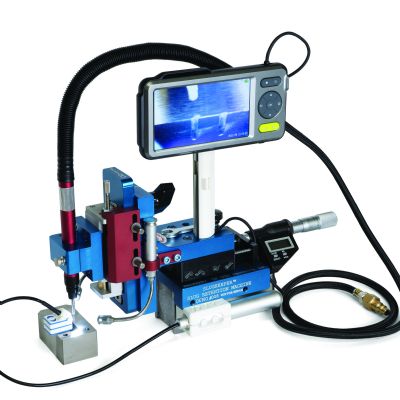How Can We Resolve Our Slug-Pulling Problem?
April 25, 2025Comments
Q: We are developing what we thought would be a fairly straightforward stamping: 2.1 by 2.3-in. rectangle, 0.004 in. thick, from Type 301 stainless steel. A single punch blanks the part through the die in one stroke. As we brought the stamping speed to 200 strokes/min., the part would pull back up with the punch, causing the raw strip stock to jam during feeding. We then added a series of 0.1-in.-dia. air holes in the punch in a pattern similar to the numeral 5 on a dice. We were careful to channel the air on the back side of the punch so that all of the holes would feed symmetrically. We then checked the air flow on the bench to ensure that the air came through all five of the holes. Then, we transferred the tool to the press, but the slug-pull problem actually worsened. Every blank traveled back up with the punch on the upstroke. How can we resolve this problem?
A: A very interesting phenomenon is going on here, and you have to try this demo to comprehend it. Set up the tool on the bench with the punch facing straight up. Next, take a part that you blanked and hold it about 1 in. away from—and oriented toward—the punch face. While supporting the part in the palm of your hand, allow the air to hold it in position directly over the face of the punch. Start to move the part closer to the punch face. As you move the part closer, it will reach a point at which the part will jump from your hand to the punch face and will remain stuck in position a few thousandths of an inch from the punch face. An air current rushing between the part and the punch face holds it in place.
The force at work here is the same as that which makes a curveball curve. When air runs faster on one side of a surface than the opposite side, the object will move toward the side with faster air flow. When it happens to an airplane, it’s called lift. In this example, at about 0.25 in. of distance between the two surfaces, the phenomenon disappears, and the air pushes the part away.
To resolve this problem, add ejector pins to all five holes.
Assuming a 2-in.-long blanking punch, counterbore air holes about 0.375 in. deep on the back side of the punch to accept the head of a standard, off-the-shelf, round, steel punch blank that will be used as a mechanical ejector. This punch blank should have a diameter of about 0.095 in. based on an air-hole diameter of 0.1 in., and its punch head should be 0.1 in. thick. Grind each ejector punch blank to about 1.95 in. long. The head on a standard 0.095-in.-OD punch blank has a 0.156-in. dia., so make the counterbore diameter 0.01 in. larger. This creates a nice slip fit with no interference, enabling the ejector to move freely up and down.
Next, grind two 0.020-in.-deep slots on opposite sides along the entire length of the ejector punch body using a 0.025-in.-wide wheel with a hand-dressed radius on the wheel face. The grooves will be deeper on the punch head.
Insert each ejector into the blanking punch and assemble the tool. Activating the air will drive down the pins, which should stick out above the punch face about 0.25 in. This action is similar to how the shaft of an air cylinder is driven. Air also escapes through the grooves in the ejector punch. As soon as the tool finishes blanking the part at bottom dead center of the press stroke, turn on the air. As the tool begins the upstroke, the pins will push the part away mechanically from the punch face. Once this occurs, the air escaping through the grooves will blow the part down through the tool.








